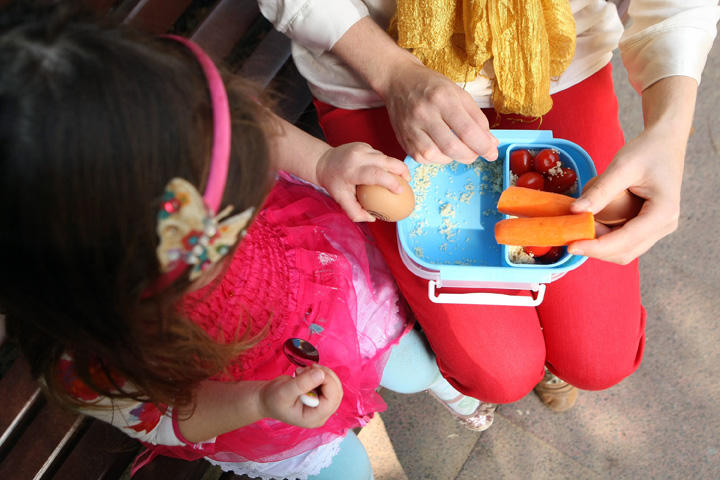TORONTO – Their pencils are sharpened, their backpacks are full and they’re off to the classroom for another school year. By noon, their tummies are rumbling and with a lunch box or some change in tow, they’re off to the cafeteria.

Parents know how tricky back to school lunch-making can be. Parents must contend with allergies and picky eaters while trying to make sure kids don’t get sick of the same old lunch each day.
“It’s hard to throw lunch together in the morning if you don’t have food in the house, you don’t know what your kids are interested in and you don’t involve your kids,” Carol Dombrow, a registered dietician with the Heart and Stroke Foundation, says.
The organization’s latest polling suggests that 64 per cent of Canadian parents send their kids off to school with lunch and snacks made from home five days a week. But how many of these brown-bag lunches are healthy and keeping kids happy at the same time?
Dombrow shares with Global News her tips on helping parents pack lunch for the school year.
Plan and prepare ahead of time
Dombrow suggests sitting down with your kids to plan two weeks of lunches and snacks. Post the meal plan on your fridge at home, so kids know what to expect for lunch the next day and you’ll know what to grab at the grocery store.
Ask them if they have preferences, likes or dislikes – this could help guide the way to making sure they’re eating their lunch.
“It’s a whole different way of going about it than giving your kids a surprise lunch every day,” Dombrow notes.
Read more: 5 tips to help make healthy eating decisions while on vacation
While making lunch the night before or in the morning, get your kids involved by helping, even with simple tasks.
“The more you involve your kids in the whole foods area, the better. That way, they’re going to be more interested in what they’re eating,” Dombrow said.
Have your food groups covered
Include a serving from each of the four food groups for lunch. That’s vegetables and fruit; grain products, dairy, and meat and alternatives. Meanwhile, snacks should include a serving from two food groups.
This isn’t hard to do, Dombrow says. A sandwich, for example, would cover grains, protein, vegetables and dairy. Yogurt and fruit could also make up a healthy snack.
Soups can also easily cover the food groups. The Heart and Stroke Foundation, along with many other websites, offers recipes tailored for the classroom.
As for portions, Dombrow suggests parents keep an eye on what their kids bring home. If they’re not eating all you’ve packed them, it may be too much. If they’re craving dinner after class, they might not be getting enough.
“You’ll know your child and judge accordingly to what they eat,” she said.
Limit the sweets and cafeteria food
Sometimes it’s easier to send your child off with Lunchables or $5 to grab lunch in the cafeteria, but Dombrow urges parents to keep this at a minimum.
“You’re paying a lot of money for foods that are high in sodium and aren’t healthy,” Dombrow said.
“The whole purpose of sending lunch and snacks to school is to give kids energy to allow them to be able to concentrate and learn. You want them to get the nourishment they need during the day.”
Read more: Preschoolers’ eating habits linked to future heart health risks, Canadian study suggests
You’re also leading by example. If kids see you packing your lunch each day, it could become a habit that follows them through their lifetime.
Avoid the store-bought, sugar-laden snacks, too.
“It’s what the kids get used to. Once you start with cookies and candies, that’s what they’re going to ask for,” Dombrow warns.
Instead, try baking homemade muffins, pack cheese and fruit, cereal or even nuts.
Giving them change for cafeteria food can be a treat, and it’ll also teach kids a bit about independence.
Keep it simple, and kid-sized
This is a small trick, but Dombrow promises it helps parents make sure their kids are eating lunch. Cut up fruit and vegetables so they’re easier to eat instead of packing a whole apple, for example. Cut up cheese cubes, or make finger sandwiches.
“It’s just using common sense but it makes it more fun for kids,” Dombrow said.
Read more: Cartoon characters key to influencing kids to eat healthier, studies show
Making lunch doesn’t have to mean turning on the stove all over again either. She suggests using leftovers and working with what’s in your pantry to put together a meal.
Think outside of the box
This means swaying away from the conventional sandwich and apple combination. No grown adult would want to eat the same lunch every day and the same goes for kids.
This is where thinking outside of the sandwich box goes a long way – buy a thermos, a small freezer pack or Tupperware with plenty of containers and get creative, Dombrow suggests.
Parents can make soups that are kept warm in a thermos, salads with dressing on the side, or frittatas. Sandwich bread can be swapped for a tortilla or a bagel.
“What doesn’t work is making the same thing every day. It’s better to give a variety and have your kids get used to a variety,” Dombrow said.
carmen.chai@globalnews.ca
Follow @Carmen_Chai



Comments